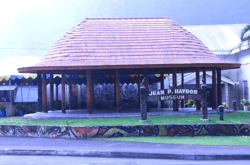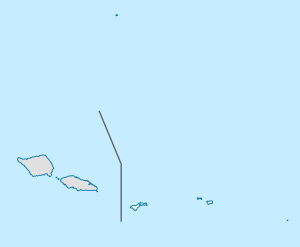Jean P. Haydon Museum
The Jean P. Haydon Museum is a museum in Pago Pago dedicated to the culture and history of the United States territory of American Samoa. It contains a collection of canoes, coconut-shell combs, pigs’ tusk armlets and native pharmacopoeia.[2] It also houses exhibits on natural history, tapa making, traditional tattooing, as well as a collection of war clubs, kava bowls, and historic photographs. Constructed in 1913 as U.S. Naval Station Tutuila Commissary, the building was home to Tutuila Island's Post Office from 1950–1971.[3] The museum has displays of various aspects of the Samoan Islands’ culture and history. It is the official repository for collections of artifacts for American Samoa. Funded by the American Samoa Council on Arts, Culture and the Humanities, it is the venue used for numerous of the cultural resource activities in American Samoa.[4]
Navy Building 43 | |
 | |
 | |
| Location | Pago Pago Harbor, Fagatogo, American Samoa |
|---|---|
| Coordinates | 14.2778°S 170.6878°W |
| Area | 0.1 acres (0.040 ha) |
| Built | 1917 |
| Architectural style | Tropical architecture |
| Part of | U.S. Naval Station Tutuila Historic District (ID90000854) |
| NRHP reference No. | 72001442[1] |
| Significant dates | |
| Added to NRHP | March 16, 1972 |
| Designated CP | June 20, 1990 |
The museum is located on the north side of Route 1 in Fagatogo, American Samoa, roughly opposite the main post office. The building in which it is located, formerly Navy Building 43 of Naval Station Tutuila, is itself historically significant as one of a few surviving buildings constructed by the United States Navy in 1917 with locally fashioned rusticated concrete blocks. The building served as the naval base's commissary until 1950, when it was turned over to civilian administration and converted to the island's main post office.[5] The post office moved to new facilities, and in 1971 the building was opened as the museum, which is named for the wife of then-governor John M. Haydon. It was dedicated by anthropologist Margaret Mead, who had returned to American Samoa to visit Ta'ū Island, where she wrote Coming of Age in Samoa.[6]
The building was listed on the National Register of Historic Places in 1972.[1] The museum was accredited by the American Association of Museums in 1978. It established close ties with the Bishop Museum of Hawai'i.[7]
Name
It is named for the wife of Governor John Morse Haydon, Mrs. Jean P. Haydon of Seattle.[8][9][10]
Collections
It houses artifacts of early Samoa, including the va'a and 'alia (bonito and war canoes) that inspired the old name for the Samoan Islands, the Navigator Islands. It also houses coconut-shell necklaces, seashell and whales' teeth necklaces, seed and fruit jewelry, pigs' tusk armlets, fly-whisks, bamboo panpipes, stone tools, siapo cloth, and a variety of weapons. Besides items commonly used in early island life, it has a display of native pharmacopeia used by early Polynesians.[11]
A portion of the museum is dedicated to the island's history with the Apollo missions. Apollo 10, 12, 13, 14, and 17 landed in the waters near Tutuila upon their return to Earth. Lunar rocks brought from the moon on Apollo missions are at display at the museum.[12] The museum is also home to an American Samoa flag, which was brought to the moon by Apollo 11 in 1969. The flag and moon rocks were given as a gift to American Samoa by President Richard Nixon following the return of the Apollo missions.[13][14]
References
- "National Register Information System". National Register of Historic Places. National Park Service. July 9, 2010.
- https://www.lonelyplanet.com/american-samoa/tutuila/attractions/jean-p-hayden-museum/a/poi-sig/1456050/362246
- Stanley, David (2004). South Pacific. Moon Handbooks. Page 479. ISBN 9781566914116.
- http://ashpo.com/downloads/library/2002-ashpo_plan.pdf (Page 10)
- "NRHP nomination for Jean P. Haydon Museum". USA: National Park Service. Retrieved 2015-06-15.
- Shaffer, Robert J. (2000). American Samoa: 100 Years Under the United States Flag. Island Heritage. Page 193. ISBN 9780896103399.
- Sunia, Fofo I.F. (2009). A History of American Samoa. Amerika Samoa Humanities Council. Page 314. ISBN 9781573062992.
- McDonald, George (1994). Frommer’s Guide to the South Pacific. Prentice Hall Travel. Page 211. ISBN 9780671866600.
- Shaffer, Robert J. (2000). American Samoa: 100 Years Under the United States Flag. Island Heritage. Page 193. ISBN 9780896103399.
- Swaney, Deanna (1994). Samoa: Western & American Samoa: a Lonely Planet Travel Survival Kit. Lonely Planet Publications. Page 167. ISBN 9780864422255.
- Swaney, Deanna (1994). Samoa: Western & American Samoa: a Lonely Planet Travel Survival Kit. Lonely Planet Publications. Pages 167-169. ISBN 9780864422255.
- Mack, Doug (2017). The Not-Quite States of America: Dispatches From the Territories and Other Far-Flung Outposts of the USA. W.W. Norton & Company. Page 87. ISBN 9780393247602.
- https://www.afar.com/places/jean-p-haydon-museum-pago-pago
- http://www.fodors.com/world/australia-and-the-pacific/american-samoa/things-to-do/sights/reviews/jean-p-haydon-museum-584573
External links
- Jean P. Haydon Museum – American Samoa Tourism Bureau